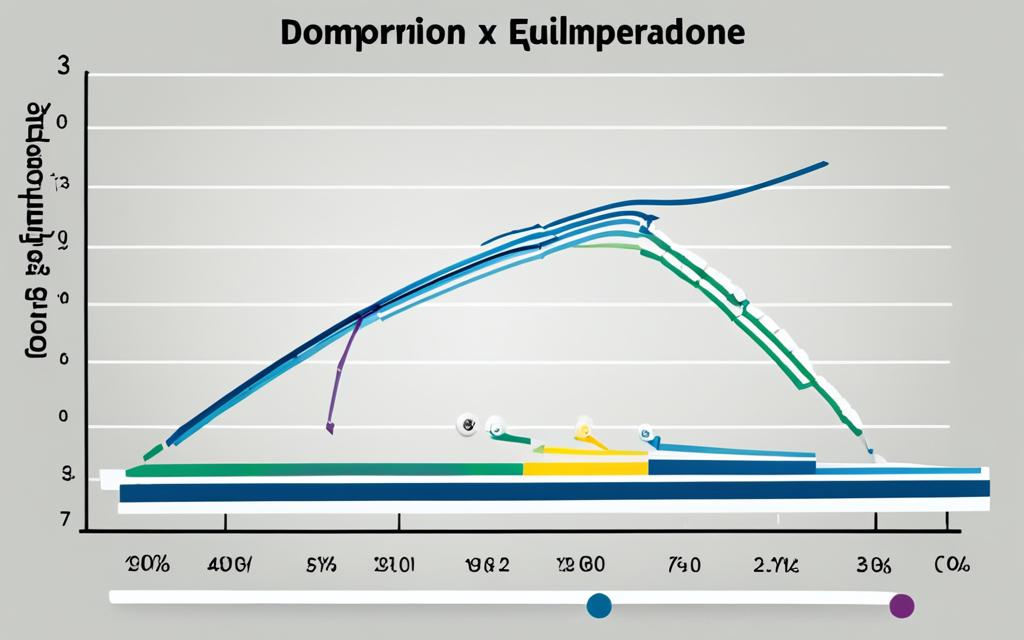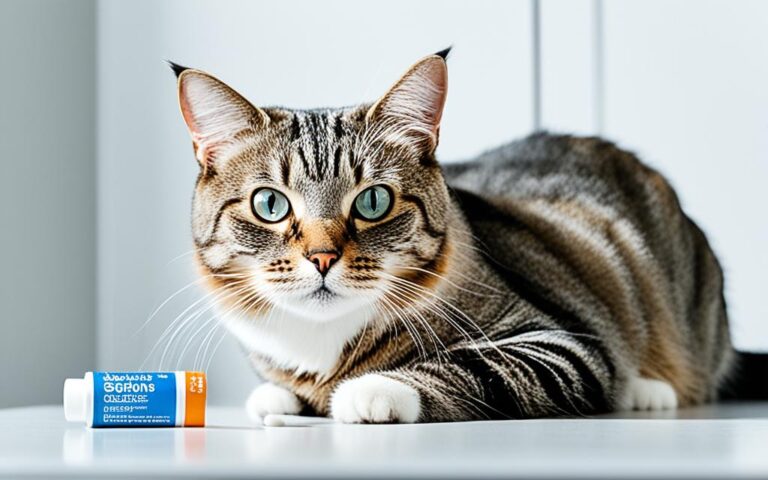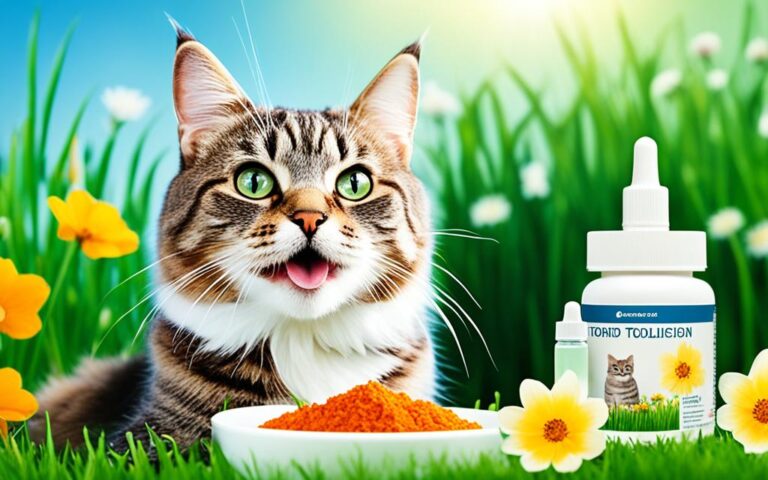Domperidone (Equidone® Gel) for Horses: Usage Guide
Each 25 cc syringe of EQUIDONE Gel holds 2.75 g of domperidone. It’s a strong equine medication, with 110 mg in each cc of gel1. This Domperidone (Equidone® Gel) does wonders for managing fescue toxicosis in pregnant mares. It stands out as a key help for horse owners and breeders.
This guide will cover everything about this key equine gastrointestinal motility medication. We’ll look at what it does, how it works, its benefits, how to use it correctly, and what to watch out for. It’s a must-read for anyone caring for horses, with all the info you need for their health and happiness.
Key Takeaways
- Domperidone (Equidone® Gel) is a prescription veterinary medication used for the prevention of fescue toxicosis in pregnant mares2
- Domperidone blocks dopamine receptors, aiming to bring back normal pregnancy hormone levels and digestion
- EQUIDONE Gel is given by mouth and avoid using it more than 15 days before birth to steer clear of bad results1
- Watch out for early milk, ailing should-be services of antibodies, and possible foal health snags as side effects13
- Knowing the right dose and how to give this medication is key to keeping horses safe and getting good results
Table of Contents
What is Domperidone (Equidone® Gel) for Horses?
Understanding the Drug and Its Purpose
Domperidone is known under the name Equidone® Gel. It’s used for treating and preventing fescue toxicosis in pregnant mares. This condition happens when mares eat fescue grass infected with a harmful fungus during the summer. It can cause issues with the mare’s pregnancy and the foal’s health2.
This drug acts by hindering dopamine receptors in mares. This brings back pregnancy hormones to a healthy level. It also boosts muscle movement in their stomachs and intestines2.
Equidone® Gel comes as an oral gel. It’s given to mares 10 to 15 days before they’re due to foal. The usual dose is 0.5 mg/lb (1.1 mg/kg) once daily4. It can be given for a few days after birth if the mare needs help making milk4.
Remember, don’t give this medicine to mares too early. It could cause problems for the foal, like being born too soon, too small, or not surviving2. Some mares may show side effects like making milk before birth, or having swollen mammary glands. Their white blood cell levels might also go up2.
“Domperidone is a valuable tool for managing fescue toxicosis in pregnant mares, but it must be used with caution and within the recommended guidelines to ensure the safety and wellbeing of both the mare and foal.”
In general, Domperidone (Equidone® Gel) is essential for relieving fescue toxicosis effects in pregnant mares. It supports the movement of the digestive system, helping to keep the mares and foals healthy241.
How Domperidone Works for Horses
Mode of Action and Mechanism
Domperidone is the key in Equidone® Gel with a super important job for horse health5. It stops the dopamine receptors, mainly the D2 ones. These decide how much prolactin is in the body5.
Pregnant mares that catch the E+ fungus get in trouble. The fungus makes their dopamine receptors overactive. Then, they lose too much prolactin, a hormone they need during pregnancy5. Domperidone steps in. It hinders dopamine from messing with the receptors. This helps bring prolactin levels back to normal. As a result, it helps the mares’ mammary glands grow right and produce milk well.
Domperidone does more than help mares stay healthy during pregnancy. It also boosts gastrointestinal motility in horses5. By stopping dopamine in the gut, food moves better. This action is great for horses with slow digestion or stomach issues.
The way domperidone works is truly versatile. It tackles many health issues in horses. From getting pregnant horses the right support to helping all horses’ gut health5. Knowing how it works helps vets and horse owners pick the best for their four-legged friends.
Benefits of Domperidone for Horse Health
Domperidone, known as Equidone® Gel, is great for horse health. It’s especially good at preventing issues related to fescue and helping pregnancies be successful6. Fescue is a popular grass that can make horses sick. It’s because of a fungus that grows on it. This fungus makes toxins that can cause many problems for horses including issues with getting pregnant, giving birth to big babies, birthing problems, and not making enough milk6.
Studies have found domperidone is better than a fake pill in stopping these problems7. Horses that got domperidone had shorter pregnancy times, made more milk for their babies, and had healthier breasts than those that didn’t get it7. More baby horses (foals) lived, and there were fewer deaths when their moms had domperidone7. So, domperidone protects horses from the bad effects of the fescue fungus, making pregnancies and baby care better.
Experts suggest giving Equidone Gel at 0.5 mg/lb once per day to pregnant horses starting about two weeks before they are due7. Keep giving it up to five days after the baby is born if the mom’s not making enough milk7. In a lab test with 32 pregnant mares, some started making milk too early, and most of their babies didn’t get enough goodness from the milk. But, in a big real-life test with 279 pregnant mares, only a few had these issues7.
Domperidone works by helping the gut move better, which is helpful against fescue toxicosis7. But, if a horse might have a gut blockage, they shouldn’t take Equidone Gel. Also, using Equidone Gel might show a wrong result on a milk test for predicting when a mom horse will give birth7.
In general, there’s a lot of science backing up the use of domperidone (Equidone® Gel) to fight fescue issues and help mares give birth and care for their babies better76. Knowing how and when to use this medicine lets horse vets and owners keep their animals healthier.
Administering Domperidone (Equidone® Gel) to Horses
Dosage Guidelines and Directions for Use
Domperidone (Equidone® Gel) helps mares with lactation problems. It’s given at 0.5 mg per pound once a day8. Start giving it 10 to 15 days before the foal due date. You can keep using it for 5 days after the foal is born if needed8.
First, you need to weigh the mare to know how much to give. Then, set the correct dose on the syringe based on the weight. Make sure the horse’s mouth is empty before putting it on the back of the tongue8.
- Weigh the mare to determine the appropriate dose.
- Adjust the multi-dose syringe to the correct volume based on the mare’s weight.
- Administer the Equidone® Gel directly onto the back of the horse’s tongue.
- Ensure the mare’s mouth is free of food when administering the medication.
- Begin treatment 10-15 days prior to the expected foaling date.
- Continue treatment for up to 5 days after foaling if needed.
| Mare’s Weight (lb) | Dose (mg) | Dose (ml) |
|---|---|---|
| 500 | 250 | 12.5 |
| 600 | 300 | 15 |
| 700 | 350 | 17.5 |
| 800 | 400 | 20 |
| 900 | 450 | 22.5 |
| 1000 | 500 | 25 |

“Equidone® Gel should not be used in horses with suspected or confirmed gastrointestinal blockage due to its prokinetic effects.”8
Careful if you’re a pregnant or nursing woman handling it. There’s no safety data for us humans8. It’s also very dangerous if too much is used. Keep it out of kids’ and pets’ reach8.
Follow the dosing and use instructions to keep your horses safe and healthy. When in doubt, talk to your vet for advice8.
Potential Side Effects and Precautions
Using domperidone (EQUIDONE® Gel) in horses requires knowing its side effects and being cautious9. Studies show up to 18% of mares have early lactation with this gel. And, 81% of their foals may not get enough antibodies9. But, a study of 279 mares found only a 1% rate for these issues9.
Domperidone can raise the count of certain white blood cells and enzymes in horses9. This might cause diarrhea in foals and a lack of maternal antibodies for them9.
Avoid using domperidone in horses suspected of having a stomach blockage. This drug helps move the gut and could worsen a blockage2. Women who are pregnant or nursing should also be careful with this drug. It might mess with their hormones2.
| Potential Side Effects of Domperidone in Horses | Incidence Rate |
|---|---|
| Premature lactation in mares | 1% to 18% |
| Failure of passive transfer in foals | 1% to 81% |
| Increased white blood cell and granulocyte counts | Variable |
| Increased GGT and/or alkaline phosphatase levels | Variable |
| Diarrhea in foals | Variable |
Owners and vets must know about these effects before using domperidone on pregnant mares and their foals92. They must watch the horses closely for any problems. This ensures the drug is used safely and works well for the animals92.
Domperidone is okayed by the FDA to avoid a problem in mares2. This problem can happen in summer from eating certain grass or seeds. But, domperidone should not be used 15 days before a mare is due to foal. It could cause problems like early birth or even the foal’s death2.
“Understanding the potential side effects and precautions associated with domperidone use in horses is crucial for ensuring the safety and well-being of both the mare and the foal.”
Knowing about domperidone’s effects is key for horse owners and vets. This helps them use the drug in the safest way possible92.
Comparing Domperidone to Other Equine Medications
Efficacy, Cost, and Safety Profile
Domperidone (Equidone® Gel) stands out in helping pregnant mares with fescue toxicosis. It beats a placebo in making mares give birth earlier. They also produce more milk and have healthier mammary glands. This leads to more foals surviving10.
It’s a top pick for fescue issues. Still, its costs and side effects need looking at10. Domperidone works by blocking dopamine receptors in the gut. So, it doesn’t mess with the brain too much. This makes it safer than some drugs in its group10.
Results from studies on adult horses are helpful. They got different doses of domperidone. Points like how quickly their food left the stomach were checked. These tests help understand the drug’s effects better10.
Domperidone also looks good for treating laminitis11. In 6 horse cases, it improved how they walked in just 2 days. It might work by controlling blood flow in the foot. This is crucial in laminitis treatment11.
Despite its good points, domperidone’s downsides need attention. It can start milk production too soon or affect a foal’s immune system. We have to balance these problems against the good it can do. Choosing the right treatment means understanding what each horse needs10.

“Domperidone has been shown to be superior to placebo control in preventing fescue toxicosis in pregnant mares.”
Missed Dose Instructions for Domperidone
When giving your horse domperidone (Equidone® Gel), strict timing matters. If you miss a dose, talking to your vet is crucial12.
If you realize you missed a dose, the vet might tell you to give it immediately. But if the next dose is near, skip the missed one. Then, just keep going as usual8.
Never up the dose to make up for one you missed. This can harm your horse. Stick to the prescribed plan for your horse’s safety8.
Your vet is always ready to help with missed doses or any other worries about domperidone (Equidone® Gel). So, feel free to call them for advice.
“If a dose is missed, the recommendation is to give the missed dose as soon as remembered, unless it is almost time for the next dose, in which case the missed dose should be skipped to avoid double dosing.”8
Storage and Handling of Domperidone
It’s crucial to store and handle domperidone (Equidone® Gel) properly for it to work safely and well for horses. Both vets and horse owners need to follow certain rules. This oral gel med has its own needs for storage and use5.
Keep domperidone (Equidone® Gel) at room temp, around 77°F (25°C). It’s okay if the temp gets between 59°F and 86°F (15°C to 30°C) sometimes. Remember, always put the cap back on and protect it from light and moisture5.
If you’re pregnant or breastfeeding, be careful when you use domperidone. It could affect your hormones. Wear gloves and wash your hands well after touching the medicine8.
It’s not known what might happen to foals if their mothers use Equidone® Gel. So, make sure you follow the right dose and handle it with care. Too much of this medicine can be really harmful. Keep it away from kids and pets8.
Following the correct steps in storing and using domperidone is key for horse owners and vets. It will help keep the horses healthy. Plus, it ensures the medicine will be safe and do its job58.
Conclusion
Domperidone (Equidone® Gel) is a key tool for vets and horse owners. It helps prevent and treat fescue toxicosis in pregnant mares13. This drug blocks the bad effects of fescue toxins. It keeps pregnancy and lactation normal, leading to better foaling and healthier foals10. Studies show its quick help with laminitis horses in just 2 days. This makes it a crucial choice for horses on endophyte-infected fescue11.
Domperidone can have side effects. But its role in improving horse gut health and treating fescue toxicosis is crucial10. Vets and horse owners find it very useful in keeping their horses healthy and productive.
In the end, Domperidone (Equidone® Gel) is very effective against fescue toxicosis challenges in horses. It benefits the animals and their keepers131011. Using it can make horse health better and support a strong equine industry.
FAQ
What is Domperidone (Equidone® Gel)?
How does Domperidone work for horses?
What are the benefits of Domperidone for horse health?
How is Domperidone (Equidone® Gel) administered to horses?
What are the potential side effects of Domperidone in horses?
How does Domperidone compare to other equine medications?
What should I do if I miss a dose of Domperidone?
How should Domperidone (Equidone® Gel) be stored?
Source Links
- No title found
- Domperidone (Equidone® Gel) for Horses
- EQUIDONE® Gel (domperidone)
- Equidone Gel 1 tube (Manufacturer may vary)
- Domperidone in Horses (Equis) | Vetlexicon
- Endophyte-Infected Fescue
- Equidone Gel 6 pack (Manufacturer may vary)
- Equidone® (Domperidone) Oral Gel – Revival Animal Health
- No title found
- No title found
- Saunders Handbook of VETERINARY DRUGS Small and Large Animal – M.Papich
- Shop all your suppliers in one place







